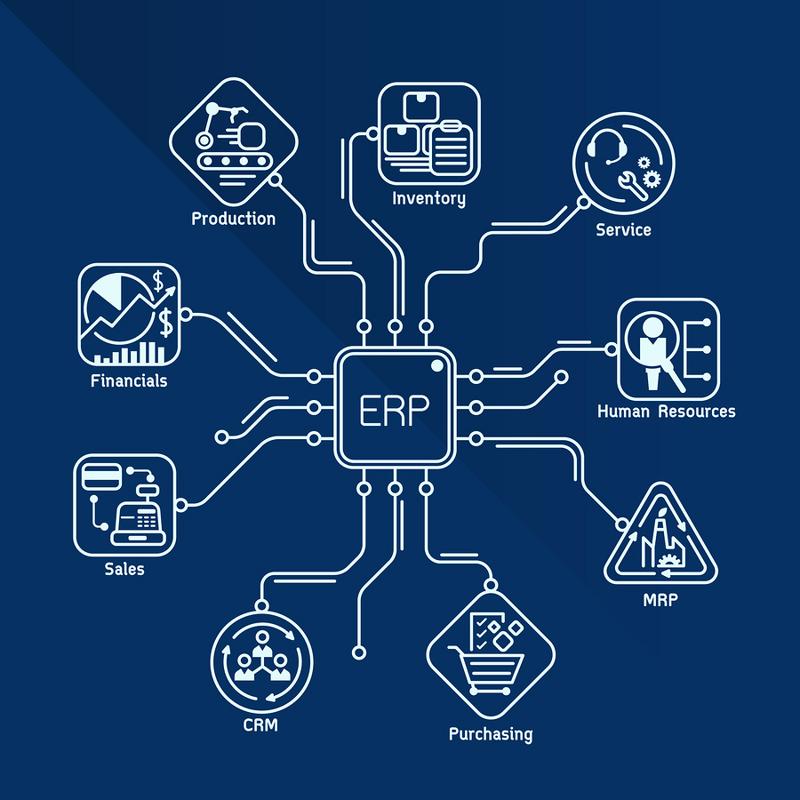
As business increases, manufacturers need to be ready to accommodate any changes. Many organizations find it useful to switch to a new enterprise resource planning system to promote growth and profitability. If your organization decides to migrate to a new ERP, you should deal with these changes proactively and efficiently to prevent problems from arising.
Reasons to Migrate to a New ERP System
In short, the primary reason organizations transition to new ERP programs is to improve their performance. This is crucial to your business, as the accuracy of any data you share can make or break your organization. Oracle explained factors that increase companies’ needs for data migration:
- Mergers, acquisitions and company restructuring.
- Compliance regulations.
- Complexity and volume of data.
- Rapid changing nature of data.
- Advances in technology.
 Enterprise resource planning will impact many components of your organization.
Enterprise resource planning will impact many components of your organization.Choosing the Right ERP Platform
Deciding on the right ERP system for your company can be exciting. You and your colleagues have the opportunity to learn new skills and utilize new technologies. When deciding what ERP technology can best benefit your organization, you should take a handful of factors into consideration.
First, you want an ERP that suits your industry. For instance, SAP caters to manufacturing execution and shop floor control. Meanwhile, Deltek offers software solutions specifically for government contractors. Financial service companies prefer to use Oracle’s E-Business Suite (EBS) or JD Edwards (JDE) ERP technology to track their finances, human capital, maintain compliance standards and assess risk management.
Ensuring the right fit is critical to avoid costly and time-consuming customizations.
Next, you want to make sure the ERP is mobile-friendly to accommodate enterprise mobility solutions, such as barcode scanners, smartphones and tablets. CIO magazine recommended asking the vendor for three references. These individuals can talk about their own experience with the ERP as well as the system’s shortcomings and successes.
Tips for Migrating to a New ERP Program
Create a transition plan before migrating. Without an adequate strategy for change management, implementation problems can result in errors, loss of crucial data and costly interruptions to regular operations. In order to conduct a productive, seamless ERP migration, you should compose a plan to ensure you and your colleagues are equipped to deal with changes. An established procedure can also help you stay on track regarding any timelines and budget expectations.
Especially if there are multiple people assigned to the migration process, creating strategic mapping will make sure you are on the same page. This should include a list of all the data that should be transferred from your old ERP to your new one. It can also make sure the data is consistent, no matter who inserted this information. For instance, some data systems do not allow for the use of alphanumeric symbols (including exclamation points, percent symbols, etc.), while others do. Creating a shared document of the implementation strategies and phases can save time and make the transition easier for everyone involved.
Provide colleagues with proper ERP training. Any employees that will likely use the ERP platform should undergo extensive instruction on how to use the technology. This can prevent human error from interfering with important data. Appoint a few individuals in the organization to be designated ERP experts, points of contact for employees to use if they have any questions or issues with the new ERP.
Only migrate the necessary data. Transitioning to a new ERP structure can be time-consuming. For efficient implementation, only migrate data you know you will need in your new ERP system. Transitioning useless information lengthens and overcomplicates the migration period. Additionally, you don’t have to transfer your data all at once. Collaborate with your team to decide what pieces of data you need and how soon you should transition this information to your new environment.
Test thoroughly before going live to your new ERP. You shouldn’t consider going live with your ERP until you perform trials of small components of the software. Set up a testing environment to solve potential issues, testing data integrity and individual transactions more amounts of your system until all the wrinkles are ironed out. Any problems not addressed during testing have the potential to impact operations after go-live.
If your enterprise is implementing a new ERP or migrating to a new ERP platform, you may also need additional functionality to extend the capabilities of your existing ERP modules. The experienced experts at RFgen can help. RFgen offers holistic inventory management, warehouse management, and field service mobility solutions that leverage cutting edge data collection tools to catalyze operational improvement and organizational growth.






